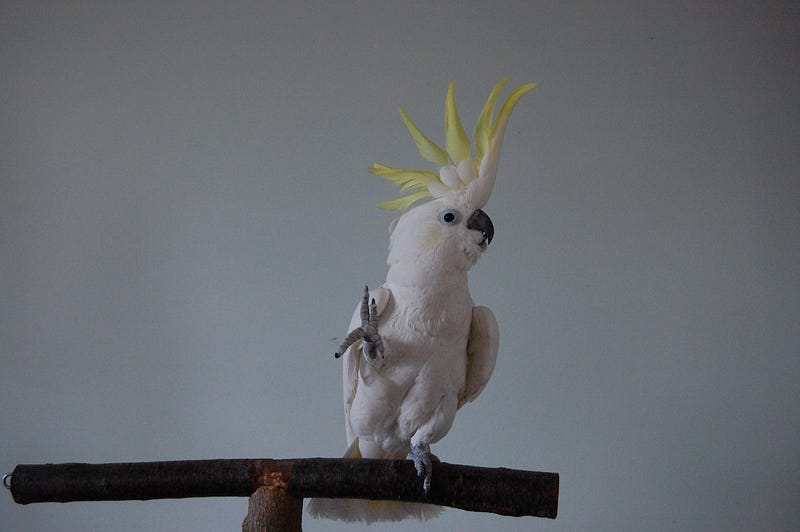Snowball the Dancing Cockatoo: A Study of Creativity and Rhythm
Written on
The Phenomenon of Snowball
Snowball, the renowned sulfur-crested cockatoo (Cacatua galerita eleonora), has captivated audiences worldwide with his impressive dance moves. Over a decade ago, he became an internet sensation after a video surfaced showing him dancing energetically to the Backstreet Boys' hit “Everybody.” Another clip from 2007 showcased him grooving to Queen’s “Another One Bites The Dust.”
Aniruddh Patel, a musician and cognitive neuroscientist at Tufts University, was one of the millions enchanted by Snowball's performances. His research focuses on how animals perceive music, contributing to our understanding of musical evolution in humans. Patel first observed Snowball's dancing while working at the Neurosciences Institute, leading to significant findings about animal behavior.
Section 1.1 Snowball’s Unique Ability
Patel's studies revealed that Snowball's inclination to dance was not merely a learned behavior but a spontaneous action, a feat not seen in our closest relatives, like chimpanzees. As the researchers noted, "It is exceedingly rare for animals to exhibit spontaneous dancing to music, especially with such varied movements."
Snowball's dancing was groundbreaking; he synchronized his movements to music in a way previously undocumented in non-human species. Patel emphasized, "In 2009, we published findings showing that Snowball instinctively aligned his movements to musical beats, a trait observed in humans across cultures but never before in other animals."
Section 1.2 The Dance of Exploration
While many birds engage in synchronized movements during courtship, true dancing to music is unheard of. Unlike trained animals that dance for rewards, Snowball's behavior emerged without any external motivation. "He developed these moves independently," Patel explained.
As time progressed, it became evident that Snowball was not just repeating familiar moves. He was experimenting with new ones. "After our initial study, we began noticing him inventing dance moves we had never seen before," Patel remarked.
Irena Schulz, who lives with Snowball and is a co-author of the study, first noted in 2008 that Snowball entered a phase of 'movement exploration.' During this time, his focus seemed to shift from precise synchronization to a broader range of movements.

To analyze these new movements, the research team recorded Snowball dancing to iconic tracks from the 1980s, including “Another One Bites the Dust” and Cyndi Lauper’s “Girls Just Want to Have Fun.” Schulz encouraged him during these sessions, but he was the sole dancer, showcasing his unique capabilities.
The lead author, R. Joanne Jao Keehn, meticulously analyzed Snowball’s movements frame-by-frame, categorizing each distinct dance move. "What intrigued us was the variety in his movements," Patel noted, highlighting that Snowball was crafting new dance routines autonomously.
Chapter 2 The Significance of Snowball’s Moves
The researchers observed that Snowball's movements were intentional yet lacked any clear external purpose. Preliminary findings suggested that he might dance differently to various songs, although more research is required to confirm this.
But where did these creative movements originate? Could it be that Snowball mimicked human dancing despite their anatomical differences? Or did his actions stem from a deeper behavioral flexibility and creativity? Either scenario is remarkable, as highlighted by the researchers.
Patel suggested that dancing, while not advantageous for wild parrots, might be an evolutionary byproduct of shared traits between humans and parrots, absent in great apes. The ability to keep time with music could also stem from these shared cognitive capabilities.
"Our findings imply that dancing to music is not just a cultural trait but rather a response to music that may arise when certain cognitive and neural capacities converge in animal brains," Patel shared.
In exploring the five key traits that might underlie this ability—vocal learning, movement imitation, long-term social bonding, learning complex sequences, and attention to communicative movements—the researchers pondered whether other animals might share these characteristics. While dolphins might possess some, they primarily bond with their species, unlike Snowball, who forms connections with humans.
Dancing serves as a social interaction for humans, and the researchers are currently analyzing Snowball's behavior under various conditions—listening to music alone, with Schulz present, and while she dances alongside him. Early observations suggest that when left to his own devices, Snowball dances in short bursts, while he moves continuously when accompanied by a human.
Source:
- Joanne Jao Keehn, John R. Iversen, Irena Schulz, and Aniruddh D. Patel (2019). Spontaneity and diversity of movement to music are not uniquely human, Current Biology, 29:R1-R3 | doi: 10.1016/j.cub.2019.05.035
For further reading, check out "Snowball The Dancing Cockatoo" by Sy Montgomery.